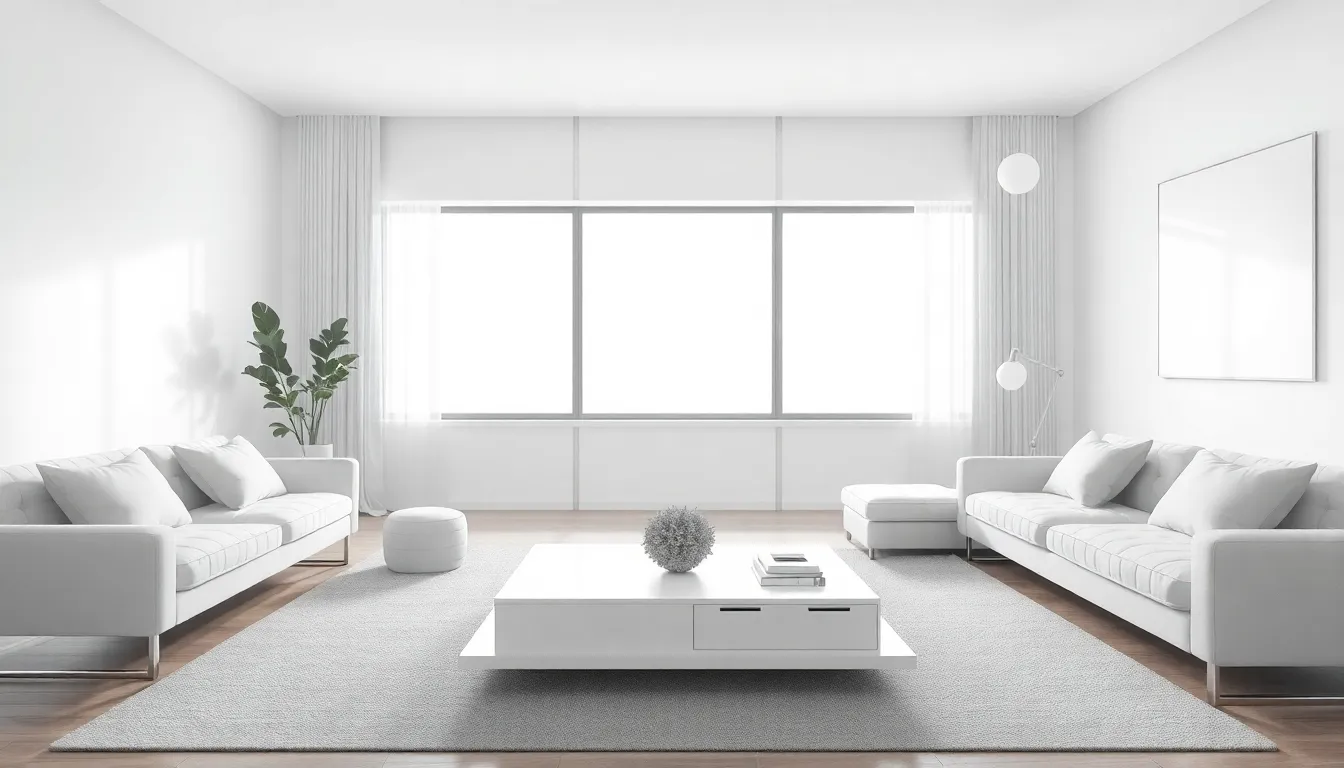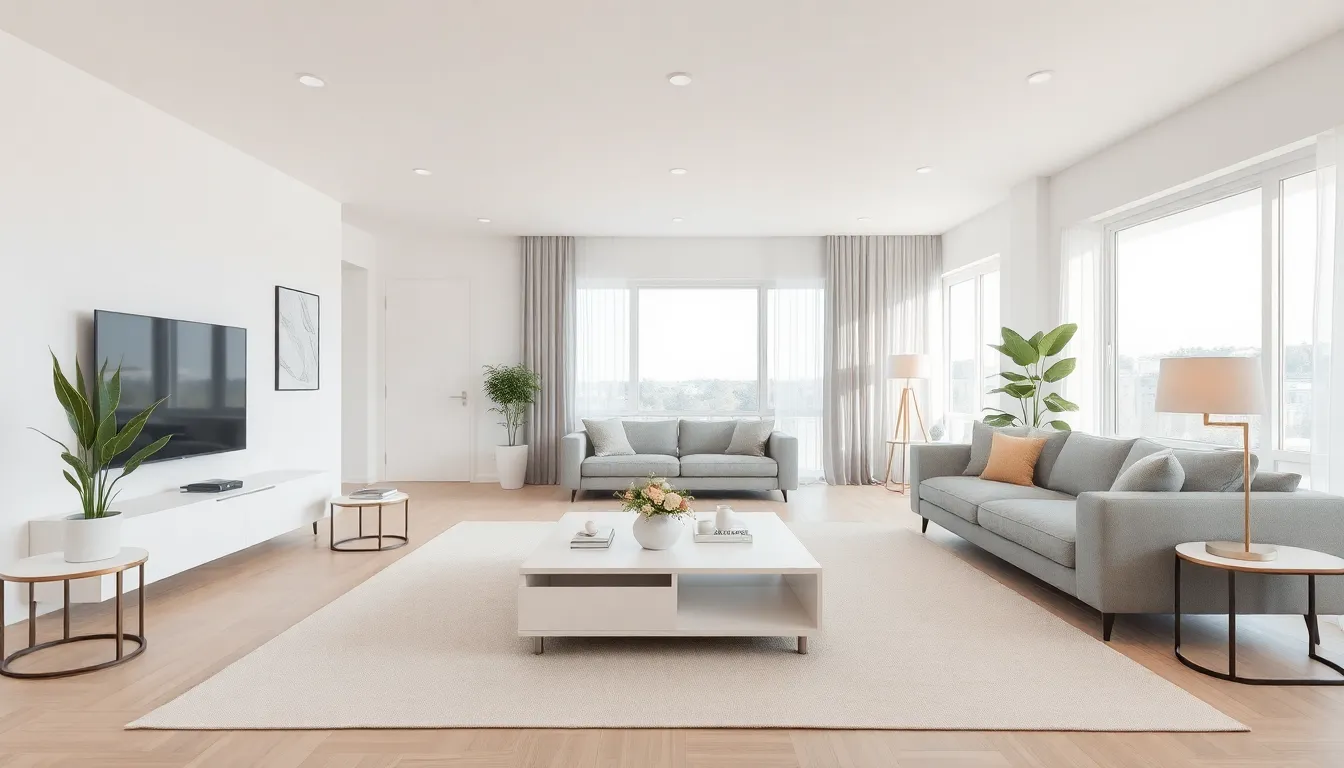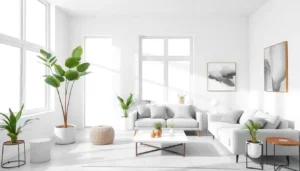Table of Contents
ToggleIn a world overflowing with stuff, the modern minimalist living room design stands out like a breath of fresh air—or maybe a well-placed potted plant. It’s all about creating a serene space that speaks volumes without shouting. With clean lines and a focus on functionality, this design style invites tranquility into the chaos of daily life.
Imagine a living room where every piece has a purpose and clutter is but a distant memory. It’s not just about fewer items; it’s about choosing the right items that spark joy—like that ridiculously comfy couch or that art piece that makes guests stop and stare. Embrace the art of less and transform your space into a stylish sanctuary that’s as inviting as it is eye-catching. Who knew simplicity could look so good?
Understanding Modern Minimalist Living Room Design
Modern minimalist living room design aims to create tranquil and functional environments. This approach prioritizes simplicity, focusing on essential elements that evoke joy.
Key Principles of Minimalism
Functionality remains a core tenet of minimalist design. Clean lines contribute to an uncluttered aesthetic, fostering an open space that feels inviting. Neutral color palettes enhance serenity, making the living room a calming retreat. Purposeful furniture remains pivotal, with each piece serving a distinct role. Natural light often plays a significant role, highlighting minimalist features while connecting the indoor space to the outdoors.
Benefits of Minimalist Design
A minimalist living room promotes an organized atmosphere. This design reduces stress by eliminating visual clutter, allowing individuals to focus on experiences rather than possessions. Energy efficiency frequently increases, due to reduced use of unnecessary items and the selection of sustainable materials. Maintenance requires less effort as fewer decorative elements mean less cleaning. Overall, embracing minimalist design naturally leads to heightened creativity and clarity in daily life.
Essential Elements of a Modern Minimalist Living Room


Creating a modern minimalist living room involves careful consideration of several essential elements that contribute to a serene and efficient space.
Color Palette
Neutral colors dominate modern minimalist living rooms. Shades like whites, grays, and beiges create a calm atmosphere. Accent colors can enhance visual interest without overwhelming the space. A cohesive color scheme promotes unity throughout the room. Soft pastels or muted tones can also be used sparingly to maintain a tranquil vibe. Anti-clutter aesthetics thrive with these colors, emphasizing simplicity.
Furniture Selection
Selecting multifunctional furniture remains crucial in minimalist design. Pieces should serve multiple purposes, such as a coffee table with built-in storage. Prioritize clean lines and geometric shapes that complement the overall aesthetic. Furniture placement should enhance flow and accessibility. Avoid excessive ornamentation, focusing instead on quality materials and craftsmanship. Minimalist furniture choices highlight simplicity while fostering an inviting atmosphere.
Decor and Accessories
Selecting decor and accessories in a modern minimalist living room focuses on enhancing simplicity and elegance without overwhelming the space.
Choosing the Right Artwork
Artwork plays a pivotal role in establishing the atmosphere. Minimalist pieces exhibit clean lines and subdued colors, aligning with the overall design. Large canvases can serve as focal points, while smaller works maintain balance. Avoid cluttering the walls; one significant piece can speak volumes. Black and white photography often complements neutral palettes. Additionally, abstract art introduces a sense of curiosity without being distracting.
Functional Decor Items
Functional decor items seamlessly blend aesthetics with practicality. Throw pillows should feature simple patterns or solid colors, contributing comfort without excess. Shelving units and side tables made from natural materials provide essential storage while enhancing visual appeal. Select decorative bowls or trays to keep everyday items organized. Floor lamps with sleek designs add light without taking up too much space. Prioritizing multifunctional features ensures every element adds value to the living area.
Layout and Space Planning
Layout and space planning play essential roles in modern minimalist living room design. They create a harmonious environment that promotes functionality and serenity.
Open Concept vs. Defined Spaces
Open concept layouts foster a sense of spaciousness. They encourage fluid movement between areas, which enhances social interaction. Defined spaces provide boundaries that create distinct zones for various activities, like relaxation and entertainment. Both styles can accommodate minimalist design principles, ensuring that clutter remains minimal while aesthetics remain appealing. When choosing between the two, consider the size of the living room and how it interacts with adjacent areas. An open concept may be ideal for smaller homes, while larger spaces can benefit from defined zones, maintaining simplicity without sacrificing style.
Furniture Arrangement Tips
Arranging furniture strategically maximizes space and enhances functionality. Start by positioning larger pieces, such as sofas, against walls. This approach opens up the center of the room, promoting easier movement. Place side tables and chairs within reach to create a cohesive seating area. Prioritize multifunctional furniture, like ottomans that offer storage solutions. Avoid overcrowding by selecting fewer, larger pieces instead of many small items. Space items evenly to promote visual balance while ensuring the room remains inviting. Natural light should guide the arrangement, with furniture positioned to take advantage of window views, enhancing the overall atmosphere.
Modern minimalist living room design offers a pathway to tranquility and functionality. By prioritizing simplicity and purposeful selections, individuals can create spaces that reflect their personal style while promoting clarity and calmness.
Embracing clean lines and neutral palettes fosters an inviting atmosphere that enhances relaxation. Thoughtful furniture arrangements and the strategic use of natural light further elevate the living experience.
Ultimately, minimalist design is more than just aesthetics; it’s about cultivating an environment that nurtures creativity and reduces stress. With these principles in mind, anyone can transform their living room into a serene sanctuary that resonates with modern elegance.










